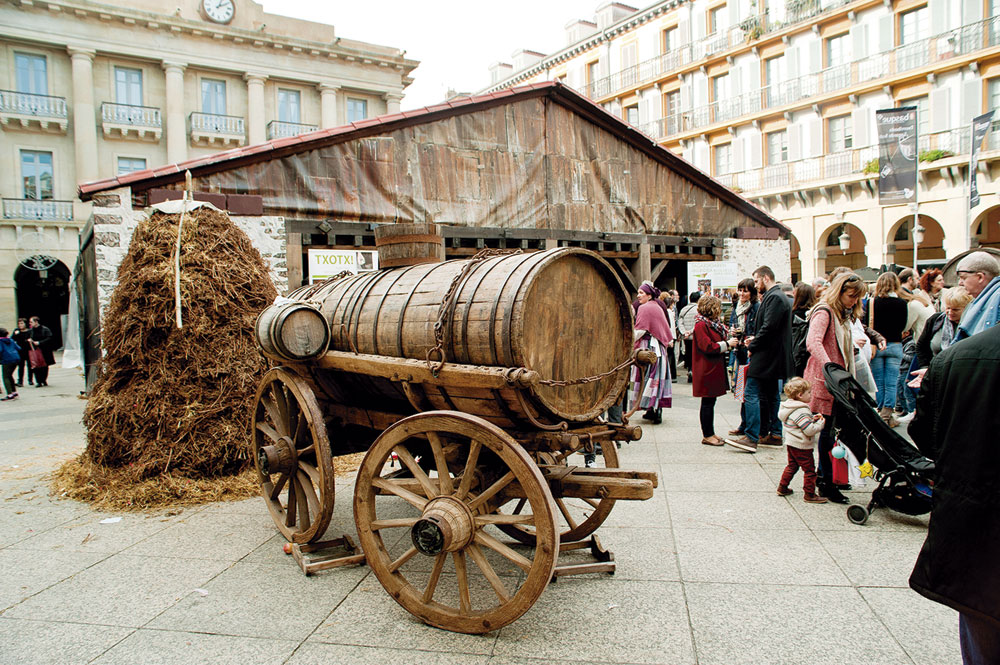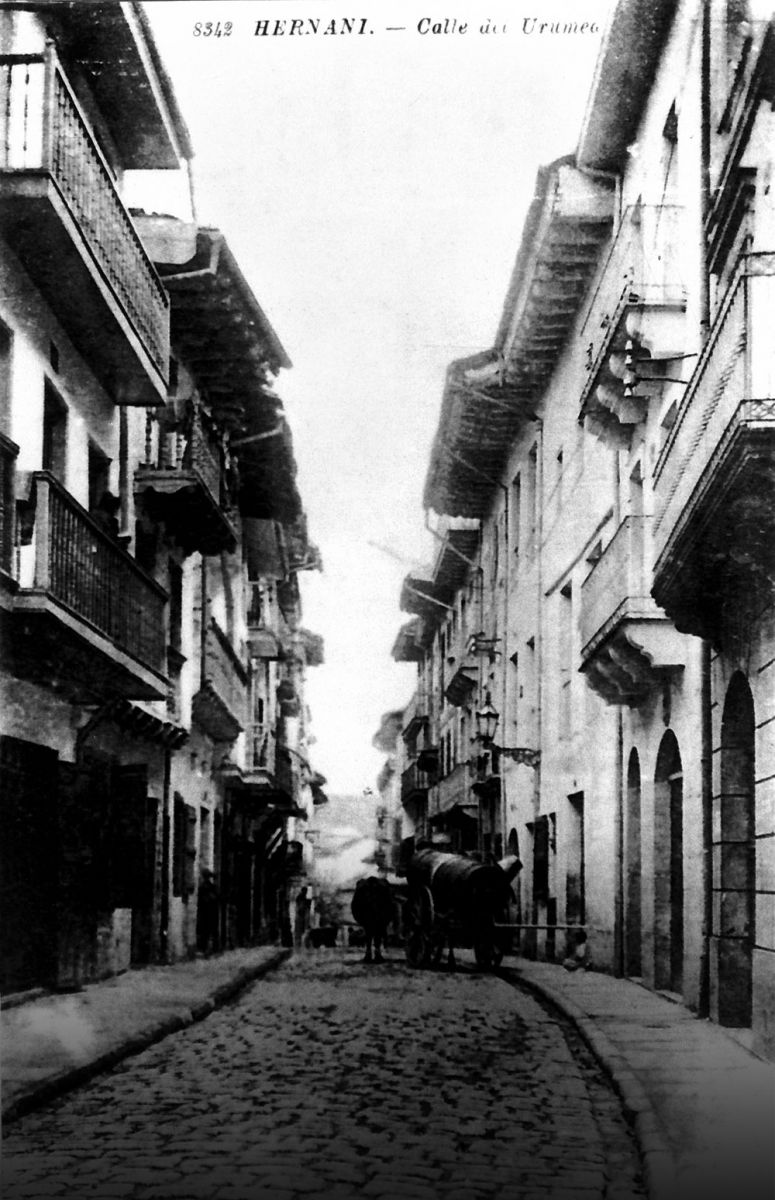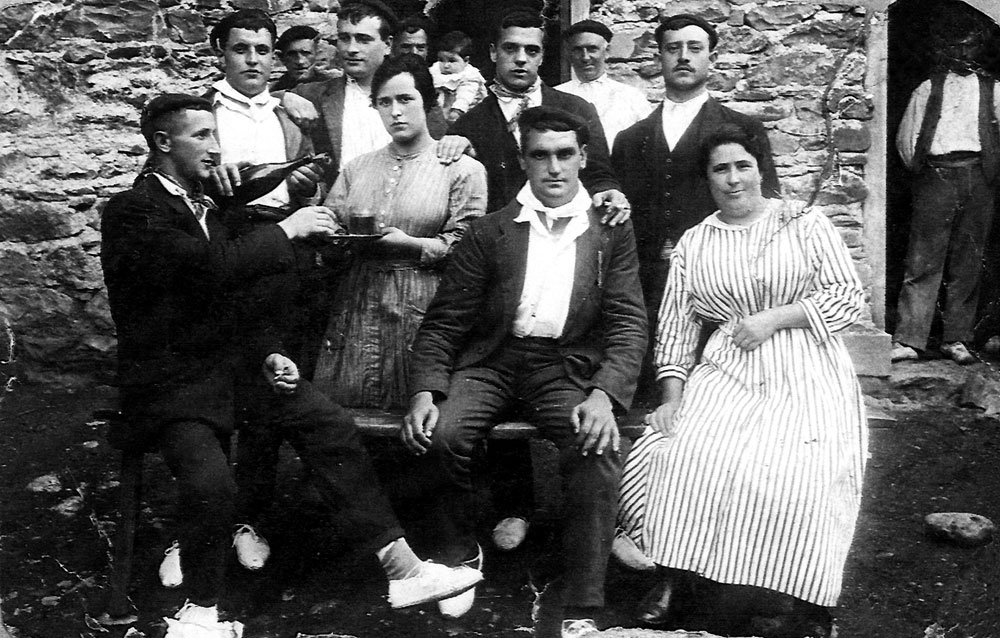
In the boulevard, tourists and citizens looked in awe at the large hamlet of dwellings placed on stone slabs. As every year, in early December the “Apurua” was celebrated in Donostia, the first tasting event of the new cider before opening the txotx season. The replica of Ezkio’s Igartubeiti farmhouse, turned into a sidrería, did not go unnoticed between the neoclassical and eclectic buildings.
We started drinking cider in can or in cup, and trying the first musts in the postmodernist corners of the pavilion or surrounded by works of art, but the cider culture remains one of the rebellious paths that lead to the periphery in the imagination of most, if you want the field. Today, the contact of citizens with cider is quite limited to the txotx season or the cider days, although the focus is spreading more and more thanks to the work of institutions and associations.
But it hasn't always been that way. Until the last century, the quarries were present in the town and had great importance in social, economic and urban life. Just as the urban orchards revolution came about, we should be prepared for the return of the urban cider.
According to classical sources of Antiquity, the territories of the Cantabrian margin had been full of apples for at least two thousand years. The tradition of making apple wine was so deeply rooted that in the 16th century it is believed that a quarter of the landscape of Gipuzkoa and a third of Bizkaia were composed of the chamomile. It has been for centuries the most common beverage in the surroundings and much of the demand was urban. Presbyterian Joaquín Ordóñez described in San Sebastian that in 1760 introduced at least 250 apples from the dwellings into the city: “This drink is drunk by all employees and servers, (…) also the big ones, because they have servers with them. You drink in many homes all year round.”
In 1828 each Donostia drank three liters of cider a day and there were dozens of cider shops in the Casco Viejo. Not in vain, with the act “Apurua” have claimed that San Sebastian is the capital of cider. “They occupy the basements or basements of the houses,” wrote in 1888 Adolfo Morales de los Ríos, author of the current City Council of San Sebastian, in the journal Euskal Erria; a winding, black and abrupt staircase leads to the winery and everything can be seen from a single glance.” Soroanekopia, Hogeitabat kupeleta, Herizenekopia, Korreopia, Mojatakua… The article contains the names of eleven quarries: “Lately they are filled with people beyond the Boulevard,” explains the architect, surprised by the success of these “urban cuba.”

Most of the time they brought the apple must out, sometimes transported by the Urumea, others by chariots. In the Old Quarter, at the end of the central street of Matia, there was a steelworks called Xexenenia, with oxen carrying the drink of the Berioazpi farmhouse of Igara; in the testimony gathered in the Ahotsak portal, Juan Zamora recalls that there were about 20,000 liters of cider with lands full of manzanales. Both disappeared, devoured by the urbanization of Berio and the expansion of the Old. In Donostia-San Sebastián there were 785 villages in the middle of the 19th century, at the end of the 20th century there were barely two hundred.
For the transport of the cider, a long barrel called barrika or garraldia was placed on the cart, while in the loss of four wheels up to three nozzles could be transported – almost 3,000 liters of cider. Oral sources are vital to represent Donostia's environment: “In the old part we had a place on Anjel Street with two barrels and there they carried the cider,” says Mertxe Arrieta de Astigarraga in Ahotsak. Her mother and two other women sold cider to the people, also to the fishermen: “At night they were going to fish and sell it to those returning in the morning, throwing them down the tap in the forest.”
This close relationship between cities and quarries has also been reflected in the papers. A document preserved in the municipal archive of Tolosa indicates that in Errementari Street there was a lagar for the elaboration of cider, built by Pedro Hospitaletxe in 1854 and that it was the object of complaint by several neighbors. In the center of Irun there were almost twenty quarries at the beginning of the twentieth century, according to a newspaper study presented in the last Euskal Jira: Berio, Olazabal, Txomiñenea, Pikabea… from Urdanibia Square to the train station.
Also in Hernani, in the center of André Street, there was something like this in the house Kardaberazenea, the birthplace of the writer and professor Agustín Kardaberaz. The building was semi-lost at the end of the 19th century by the bombs of the Carlist wars, and when Juana María Eleizegi began the reconstruction work, she wrote a curious inventory of what was there: frame, pats, locks, pisons of chopping the block… Therefore, a lagar in the heart of Hernani’s hull!
In the old photographs we can see oxen carts with barrel placed in the middle of the steep roads of the streets of Hernani, since still entering good condition the 20th century was built shears in a town that today is the epicenter of the txotx. In 1911 Eugenio Gorrotxategi opened the lagar and the winery in Izpizua Street, and in 1913 José Adarraga began the work to place the lagar in the market of Urbieta Street. In the years leading up to the war, these were Hernani’s large planters, along with the Rekondo Astiasu and Rezola families. Adarraga, for example, produced in 1931 56,325 litres of cider and Gorrotxategi, 49,500 litres of cider, according to a municipal report published today.
Thanks to the testimony that Dobera Euskara Elkartea received in 2003 from Luis Gorrotxategi, we can learn how Hernani street grids worked. His father, Eugenio, had two sidrerías, one next to the urban center and the other on the same street, behind the carnage. “Get people out of work at noon, drink a glass and eat. Then, once at six o’clock, each one had his snack or came with the work dinner to the shallow, good atmosphere!” Luis said.

They were, therefore, clients of the quarries that lived within the working hours. In Hernani, before the war, paper and tissue factories abounded, and in this industrial landscape cider bars were also linked to men's leisure. No woman would look there if she didn't serve. One of them was Regina Gorrotxategi, sister of Luis. “Then the women were at home to work.” Regina said that those who were going to have breakfast were charged 5 cents, as in his house they also sold the cider directly from the tap, and, unlike now, they would not open the other until they finished a barrel – the gorrotxatarras had barrels of up to 3,000 liters in the Gran Vía.
In front of them the ones of Rekondo, not far from there Rezola… “then the sidrry was a lot.” And with the drink, more than one had a throat ready to sing; from Luis Gorrotxategi we have come some coplas from then:
Will I
be the best cider?
Astiasu, Adarraga,
will Eugene have?
Many others also sell
a lot, alas! Here's
the work that has hit us
to try!
Why did sidrerías disappear from the streets of our peoples in the coming decades? The post-war years were very complicated, with the predominance of isolation, the sale of cider had little benefit and became a marginal complement in most of the casereal works. In the words of historian Lourdes Odriozola, the Pomology Committee of the Provincial Council of Gipuzkoa, which in previous times had worked so much to promote the production of apple, was practically dissolved and “were lost 40 years”.
So, the chamomile came out to the back and the pines were planted in many places. After leaving the lagars, in 1967, the syrup sank: 1,250,000 liters of cider were produced in the Basque Country, the lowest figure in history.
The Franco regime looked at its navel, taking measures against Basque territoriality, adjusting the legislation and banning in practice the sale of cider: “They put Christ’s tax on him, I made the last cider in 1945, and from then on he is already there,” said Luis Gorrotxategi. In addition, from the 1950s, wine consumption increased – then also that of beer – which was commercially much more bearable. In Hernani, many bars in the town of Fuenmayort and Fuente Jalon have taken the wine for the first time. Modern pubs and breweries have multiplied over the next few decades, and old dryers have been driven out of gentrified streets without sidewalks. However, in recent years, this drink is taking on a new way of life in these streets, in the form of a pintxo pote, a drink for the terrace or marized meals.